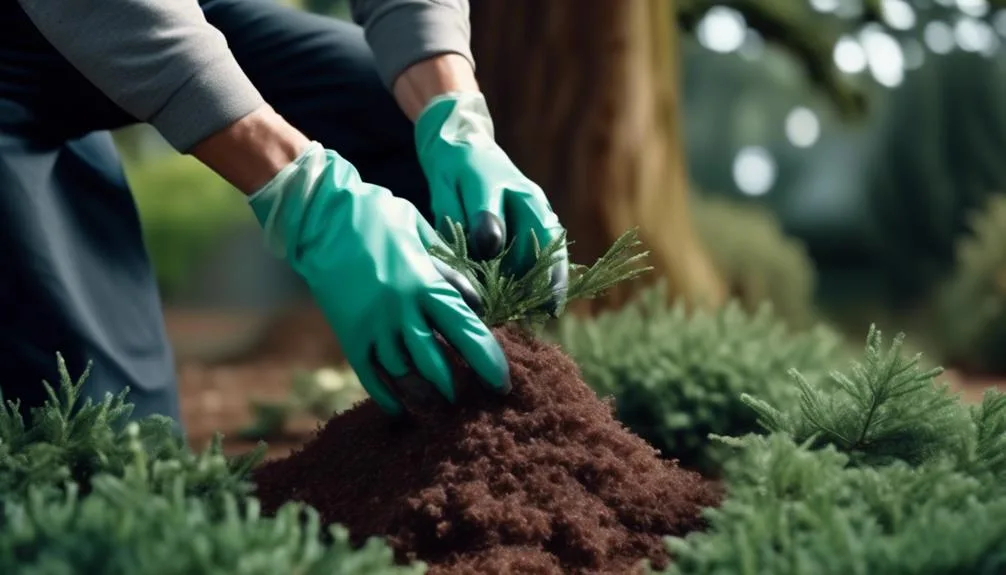Wondering how to give your cedar trees a boost? Fertilizing them is like giving a shot of espresso – it provides the extra nutrients they need to thrive. Choosing the right fertilizer and knowing when and how to apply it can be tricky.
In this guide, we'll walk you through everything you need to know to keep your cedar trees healthy. Let's get started on the path to flourishing cedars!
Understanding Cedar Tree Nutrient Needs
To support the healthy growth of your cedar trees, it's important to understand their specific nutrient needs and how to provide them with the essential elements for thriving.
Soil testing is crucial to identify any nutrient deficiencies that may be hindering the health of your cedar trees. By analyzing the soil, you can determine which nutrients are lacking and take targeted measures to address these deficiencies.
Common nutrient deficiencies in cedar trees include nitrogen, phosphorus, and potassium. Once you have identified any deficiencies, you can then choose the appropriate fertilizer to replenish the lacking nutrients.
Understanding the specific nutrient needs of your cedar trees is essential for ensuring their long-term health and vitality. Regular soil testing and proactive measures to address nutrient deficiencies will contribute to the overall well-being of your cedar trees.
Identifying the Best Fertilizer for Cedars
When identifying the best fertilizer for cedars, consider the specific nutrient requirements of your trees and choose a balanced fertilizer that addresses any identified deficiencies. To ensure you select the right fertilizer, keep in mind the following:
- Choosing the right fertilizer
- Conduct a soil test to determine the specific nutrient deficiencies of your cedar trees.
- Look for a balanced fertilizer with a ratio such as 10-10-10 or 12-6-6 to provide the necessary nitrogen, phosphorus, and potassium.
Remember to consider the application frequency and organic options when selecting the best fertilizer for your cedar trees.
Proper Timing for Applying Fertilizer
Consider timing the application of fertilizer to your cedar trees during their active growing period to maximize their nutrient uptake and promote healthy growth. The optimal timing for fertilizer application is in early spring, just as new growth begins, or in late fall before the trees go dormant.
Applying fertilizer during these periods ensures that the cedars have access to essential nutrients when they need them the most. Avoid fertilizing during periods of extreme heat or drought, as this can stress the trees and lead to fertilizer burn.
Additionally, it's important to follow the instructions on the fertilizer package to prevent over-fertilization, which can harm the cedars.
Techniques for Fertilizing Cedar Trees
As you plan to fertilize your cedar trees, it's essential to employ effective techniques that support their growth and health, building upon the optimal timing for application discussed earlier.
To ensure the best results, consider the following techniques:
- Deep root, slow release techniques
- Apply granular fertilizers deep into the soil to reach the cedar tree's root system.
- Choose slow-release fertilizers to provide nutrients gradually, promoting sustained growth and minimizing nutrient runoff.
- Organic, natural alternatives
- Utilize compost or well-aged manure to enrich the soil naturally, fostering a healthy environment for cedar trees.
- Consider using organic fertilizer blends that are tailored to the specific needs of cedar trees, providing essential nutrients without synthetic additives.
Employing these techniques will contribute to the overall health and vitality of your cedar trees.
Avoiding Common Fertilizing Mistakes
To ensure successful fertilization of your cedar trees, it is crucial to be mindful of common mistakes that can hinder their growth and health. Here are some troubleshooting tips to help you avoid these errors:
| Common Mistakes | Troubleshooting Tips |
|---|---|
| Using too much fertilizer | Measure the fertilizer carefully according to the instructions. |
| Applying fertilizer at the wrong time | Fertilize in early spring before new growth appears. |
| Neglecting soil testing | Test the soil to determine the specific nutrient needs of your cedar trees. |
| Using the wrong type of fertilizer | Choose a balanced, slow-release fertilizer specifically formulated for evergreen trees. |
| Fertilizing too close to the trunk | Apply fertilizer evenly around the drip line to reach the tree's feeder roots. |
Conclusion
By tending to the nutrient needs of your cedar trees and applying the right fertilizer, you can ensure their long-term health and vibrancy.
With proper care, your cedars will continue to enrich your landscape for years to come, adding timeless beauty to your surroundings.
Mark Hoffman is a dedicated arborist and tree care specialist with over a decade of experience. His love for trees began when he visited Yosemite National Park as a teenager and was awestruck by the giant sequoias. Mark pursued his passion by studying forestry at Michigan Technological University, where he earned a Bachelor of Science degree.
Since then, he has worked tirelessly in the field of arboriculture, helping to preserve and protect trees in his community. His expertise and dedication have made him a respected leader in the industry and a valuable resource for anyone seeking advice on tree care.
